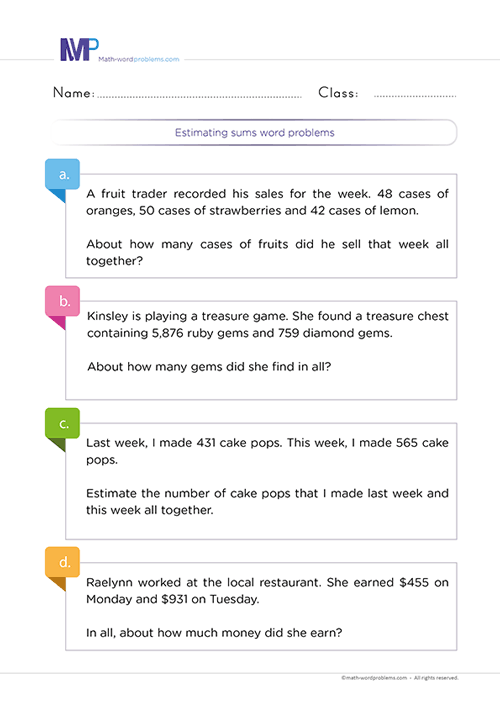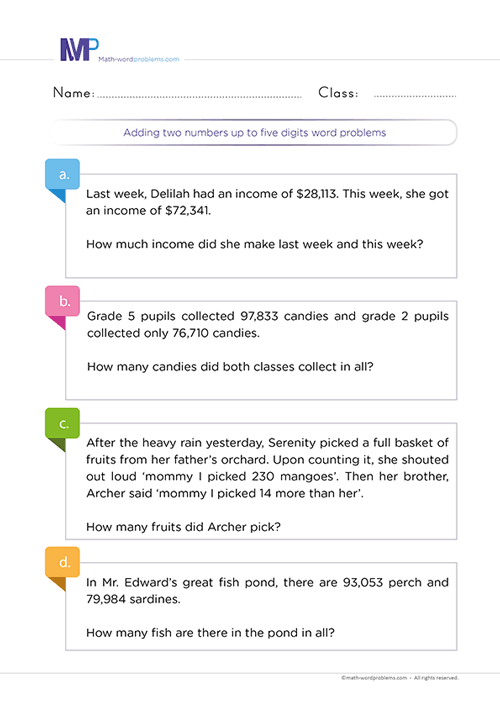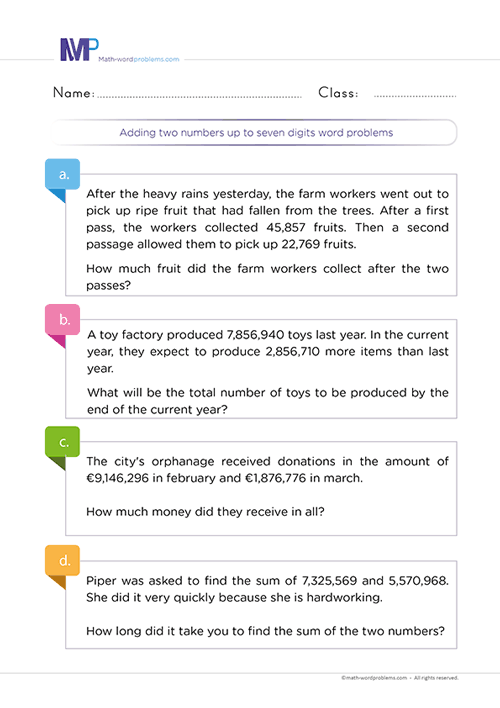 Strategy to perform estimation of sums word problems
Strategy to perform estimation of sums word problems
We are here to offer your 4th Graders the best strategy to perform estimation of sums word problems. This unique strategy will help organize your kid's thoughts and enable them to efficiently formulate appropriate equations from estimating sums word problems.
Most importantly, we will provide simple tips to help kids interpret pertinent information in the problem structure and eventually solve the estimation of sums word problems effectively.
Ultimately, kids will have tremendous confidence in their mathematical computations as they tend to use our fun strategy to perform estimation of sums word problems.
Steps to solve estimation of sums word problems
As mentioned above, these captivating steps to solve estimation of sums word problems will significantly enhance fourth Grader's mental and estimating sums solving skills.
This step-by-step guide will also provide them with a gradual and coherent way to read, understand, and identify the problem before solving the estimation of sums.
Additionally, this excellent resource cannot be complete without us adding some outstanding real-life examples to show learners how our strategy to perform estimation of sums word problems works. So, we encourage kids to go through these exceptional examples as we illustrate them using the unique steps we designed.
IDENTIFY THE PROBLEM:
To identify the problem, start by carefully reading the word problem and highlighting facts such as what the problem wants you to solve, numbers and important keywords.
- Firstly, suppose it is estimating whole numbers involving addition word problems. In that case, you will see at least one of the keywords below: - add, plus, more, total, increase, together, Altogether, combined, sum, grow, join, both, in all, and, how many in all, how much, spend in all, etc.
- Secondly and most importantly, there are two ways to formulate or determine if a word problem requires you to estimate. If you find the words "about … "and "estimate …" in a word problem, then it is an estimation problem.
In addition to this, you have to take note of the following:
- Know and understand your place values.
- Know when to round up or down.
Note: One key Element for learners to understand is that they should not always rely on keywords alone. That is to say; the same keyword can have different meanings in different word problems.
For this reason, we reiterate on the importance of reading the question very carefully to understand the situation that the word problem is describing, then figure out exactly which operation to use
STRATEGIZE AND DETERMINE THE OPERATIONS:
Now, ask yourself, "how can I solve this problem?
One key thing you should remember is that each word problem may require a different format. Hence, the key points below will enable young math learners to tackle any format however it comes.
- First, the keyword in the word problem will help clarify the operation that you need to carry out.
- On the other hand, know that you must not rely merely on keywords. Also, try to understand the situation that the problem is describing.
SET UP A NUMBER SENTENCE AND AN EQUATION:
- After knowing which operation you will perform, construct short phrases to represent the given word problem. This visual representation of the most vital information makes it easier to solve the word problem.
- Then, write down a numerical equation representing the information given in the word problem.
SOLVE THE PROBLEM:
Now, after writing down the math problem (numerical equation), you can go ahead and solve the problem. But before you do that, there are a few steps to follow when estimating or rounding.
- Firstly, look at the number to the immediate right of the digit to be rounded.
- If that number is 0−4, keep the digit (to be rounded) unchanged, then replace all numbers to the right of that digit with 0.
- But if that number is 5−9, increase the digit (to be rounded) by 1, then replace all numbers to the right of that digit with 0.
- Finally, don't forget to include the unit of measurement, if any.
VERIFY YOUR ANSWER:
Finally, check your work to make sure that your answer is correct. Ask yourself this question. "Does my answer make sense?" If "YES," you are done. If "NO," go back to step 1 and start all over again.
Examples on how to perform estimation of sums word problems
Example One
Step 1: The important numbers here are $256 and $456. The keyword(s) found in the word problem is "in all."
Step 2:Next, ask yourself this, "How can I go about solving this problem? The keyword(s) found in the word problem calls for you to use an addition operation, and the phrase "about" shows that we have to estimate.
Step 3:Now, construct short phrases to represent the given word problem. Furthermore, write down a numerical equation representing the information given in the word problem.
- Amount of money she earned on Monday = $256
- Amount of money she earned on Tuesday = $456
- Therefore, the estimated amount of money she earned in all = the Estimated amount she earned on Monday + the estimated amount of money she earned on Tuesday.
$256 + $456 ≈ ?
Step 4: From step 3 above, stack the values in the equation you formed so that their place values should line up. Then, go ahead and add the values.
But before you do that, there are a few steps to follow when estimating or rounding.
- Firstly, look at the number to the immediate right of the digit to be rounded.
- Then, if that number is 0−4, keep the digit (to be rounded) unchanged, then replace all numbers to the right of that digit with 0
- But if that number is 5−9, increase the digit (to be rounded) by 1, then replace all numbers to the right of that digit with 0.
- Finally, don't forget to include the unit of measurement in the final result.
So, she earned about $800 in all.
Step 5: Finally, check your work to ensure your answer is correct. Ask yourself this question. "Does my answer make sense?" If "YES," you are done. If "NO," go back to step 1 and start all over again.
Example Two
Step 1: The important numbers here are 75, 95, and 14. The keyword(s) found in the word problem is "altogether."
Next, ask yourself, "How can I solve this problem?"
Step 2:Next, ask yourself this, "How can I go about solving this problem? The keyword(s) found in the word problem calls for you to use an addition operation, and the phrase "about" shows that we have to estimate.
Step 3:NNow, construct short phrases to represent the given word problem. Furthermore, write down a numerical equation representing the information given in the word problem.
- Number of cases of strawberries that he sold = 75.
- Number of cases of oranges that he sold = 95.
- Number of cases of apples that he sold = 14.
- Therefore, the estimated number of cases of fruits he sold = the estimated number of cases of strawberries he sold + the estimated number of cases of oranges he sold + the estimated number of cases of apples he sold.
75 + 95 + 14 ≈ ?
Step 4: From step 3 above, stack the values in the equation you formed so that their place values should line up. Then, go ahead and add the values.
But before you do that, there are a few steps to follow when estimating or rounding.
- Firstly, look at the number to the immediate right of the digit to be rounded.
- Then, if that number is 0−4, keep the digit (to be rounded) unchanged, then replace all numbers to the right of that digit with 0
- But if that number is 5−9, increase the digit (to be rounded) by 1, then replace all numbers to the right of that digit with 0.
- Finally, don't forget to include the unit of measurement in the final result.
So, he sold about 190 cases of fruits last week
Step 5: Finally, check your work to ensure your answer is correct. Ask yourself this question. "Does my answer make sense?" If "YES," you are done. If "NO," go back to step 1 and start all over again.






